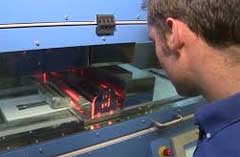The per piece cost focus of most procurement organizations and the way supply managers are trained and measured are significantly holding back use of 3D printing in the US automotive industry.
So says Steve Tengler, a regular contributor to the Forbes.com web site with a long history in the sector, in a recent post.
Is he right?
Supply Chain Digest Says... |
 |
| The costs of storing millions of usually very slow moving repair parts inventory is huge, in terms of labor, space and carrying costs. |
 |
What do you say? |
| Click here to send us your comments |
 |
| Click here to see reader feedback |
|
|
Buyers are woefully behind the times, Tengler writes.
“Much like a Clydesdale, this blinder-laden workhorse is rewarded for its focused attention on the task in front of them – specifically a lower Bill of Materials (BOM) cost for the vehicle or system,” adding that this “myopic viewpoint is seen as an advantage over engineers who might get distracted by new technology.”
Rarely or barely, Tengler says, are buyers allowed to use formulas for purchase decisions beyond the tangible costs per piece. Sometimes an attribute such weight is given some play, but in the end, it is “get the cost down – period,” Tengler says.
And that doesn’t give 3D printed components much of a chance, because on a per piece basis 3D printed parts will always be more expensive than mass produced ones.
But by looking at total lifecycle costs, Tengler says, a different picture emerges. Costs that are reduced from 3D printing include:
Rapid Prototyping: Quickly create a “Minimum Viable Product” (MVP) that can be tested that with users and stakeholders, driving fast design changes based upon feedback.
Production Jigs and Tools: Tengler says the long pole in getting a vehicle to market is tooling. It can take 52 weeks in some cases to get a tool designed, released, built, and milled. There are also huge costs related to the waste created to qualify a part, which the time for qualifying, disposal, etc. typically is not being measured.
With 3D printing, that process goes away, delivering improvements in cost and speed, and greatly reducing systemic waste in the sourcing process.
Advantages for Low-Volume Parts Production: Usually, Tengler says, the cost of production tooling is amortized over a million parts. But for smaller run parts, the tooling costs per piece are high. Tengler quotes one expert who notes there are a lot of vehicle models that are produced in sub-5,000 volumes.
For those parts, 3D printing may actually reduce fully burdened part costs per piece.
(Article Continued Below)
|
CATEGORY SPONSOR: SOFTEON |
|
|
| |
|
|
 Vehicle Weight Reductions: 3D printed parts can weight a lot less than traditionally produced components, Tengler says, such as through use of lattice-structures in the build. Vehicle Weight Reductions: 3D printed parts can weight a lot less than traditionally produced components, Tengler says, such as through use of lattice-structures in the build.
“Meeting or exceeding Corporate Average Fuel Economy standards certainly means real dollars to companies” and fuel savings for consumers, Tengler notes.
Functional Safety: The lattice-structured parts can also promote safety, Tengler says, as 3D printing can create extremely strong parts with crumple zones.
“Shockingly, something as fundamental as safety is frequently not a multiplier for buyers,” Tengler observes.
Avoiding Supply Chain Disruptions: The impact of global supply chain disruptions, from fires to natural disasters and more can be avoided by moving to local 3D printing with much fewer risk points and variables.
Parts Operations: The costs of storing millions of usually very slow moving repair parts inventory is huge, in terms of labor, space and carrying costs. Those costs might be dramatically reduced by printing repair parts as needed.
Obsolescence: Similarly, when demand for a part significantly declines or goes away completely, commonly existing inventory must be scrapped, a cost that goes away when parts are printed on demand.
Procurement organizations and buyers need to remove their blinders and see the full financial picture of 3D printing and additive manufacturing.
When they do, “the will find the chance to print money,” Tengler concludes.
Do you agree companies are not fully considering total costs of traditional parts vs 3D? Let us know your thoughts at the Feedback section below.
Your Comments/Feedback
|